The Occupational Safety and Health Administration has issued guidance on preparing workplaces for a COVID-19 coronavirus outbreak. The guidance breaks down risk categories and recommendations on how employers can reduce workers’ risk of exposure.
*We’re continuing to report on OSHA’s response to COVID-19, a respiratory disease caused by a novel Coronavirus first identified in Wuhan, China in December 2019.
The new guidance divides employers into four risk categories including low exposure, medium exposure, high exposure, and very high exposure. Each category has corresponding recommendations for engineering controls, administrative controls, and personal protection equipment to keep employees from contracting the virus.
Related: Employer Responsibility for Coronavirus
OSHA is urging employers to follow the guidance and prepare immediately for a potential coronavirus outbreak. Failing to prepare may leave employers without adequate resources or trained employees during a quickly moving outbreak.
How to Protect Employees During The Coronavirus Outbreak
Read the chart below to determine how to best protect employees:
| Risk Category | Very High Exposure | High Exposure | Medium Exposure | Low Exposure |
| Employers Covered |
Healthcare workers performing aerosol-generating procedures
Laboratory personnel collecting or handling specimens from known or suspected COVID-19 patients Morgue workers performing autopsies on bodies of persons known or suspected of having COVID-19 |
All other healthcare workers exposed to known or suspected COVID-19 patients
Paramedics/EMTs who are moving known or suspected COVID-19 patients Mortuary workers preparing bodies of persons known or suspected of having COVID-19 |
Workers whose jobs include frequent or close (within 6 feet) contact with other persons, and others who work in high-population density work environments | All other workers |
| Engineering Controls |
Ensure proper air-handling systems are installed and maintained in healthcare facilities—follow CDC recommendations Place patients with known/suspected COVID-19 in airborne infection isolation room Use isolation rooms for performing aerosol-generating procedures on patients with known/suspected COVID-19 Follow CDC guidance on postmortem activities Use Biosafety Level 3 special precautions when handling specimens from known/suspected COVID-19 patients |
Same as Very High Exposure | Install physical barriers, such as clear plastic sneeze guards | No additional controls recommended |
| Administrative Controls |
Develop and implement policies that reduce exposure Post signs requesting patients and family members immediately report symptoms of respiratory illness on arrival at healthcare facility Request known/suspected COVID-19 patients use face masks Consider offering enhanced medical monitoring of workers during COVID-19 outbreaks Provide job-specific training on COVID-10 prevention Ensure psychological and behavioral support is available to address employee stress |
Same as Very High Exposure |
Inform customers about COVID-19 and ask sick customers to minimize contact with workers
Limit customer/public access to worksite Consider strategies to minimize face-to-face contact Communicate availability of medical screening |
Monitor CDC COVID-19 website and public health communications |
| Personal Protective Equipment (PPE) | “Likely need” gloves, gown, face mask, and/or face shield or goggles | Same as Very High Exposure | “May need” some combination of gloves, gown, face mask, and/or face shield or goggles | Not recommended |
These recommendations are in line with guidance issued by the Centers for Disease Control and Prevention (CDC) for business and employers. OSHA also included recommended steps that all employers can take:
- Developing an infectious disease prevention and response plan
- Staying aware of guidance from federal, state, local, tribal, and/or territorial health agencies
- Using social distancing: stagger work shifts, downsize operations, deliver services remotely, and use other measures such as telecommuting to reduce exposure
- Cross-training workers to continue operations in the event of large scale employee absences
- Encouraging proper hygiene etiquette such as frequent and thorough hand washing, and developing policies and procedures for promptly identifying and isolating sick employees
OSHA is encouraging employers to, when possible, implement flexible sick leave policies, permit employees to stay at home with a sick family member, and to not require a health provider’s note for those sick with acute respiratory symptoms.
Related: OSHA Addresses Coronavirus & Employee Exposure
While there is no standard that specifically covers COVID-19 exposures, the General Duty Clause still applies to the coronavirus outbreak.
Under OSHA’s statute, employers are required to ensure that on-the-job conditions are free of serious hazards that can cause death, illness, or injury. The bloodborne pathogens and personal protective equipment standards also apply in certain circumstances.
***
About Worksite Medical
In most cases, OSHA requires medical surveillance testing, and at no cost to employees.
Worksite Medical makes that program easier with mobile medical testing.
We conduct on-site respirator fit tests, as well as pulmonary function test and heavy metal lab work, right on your job site. We also keep accurate, easy-to-access medical records for your convenience. You’ll keep your employees at work, and stay ahead of OSHA inspections.
With Worksite Medical, a mobile medical testing unit — we can bring all the resources of a lab to you. Our certified lab technicians can perform both qualitative and quantitative respirator tests to ensure a perfect fit.
Protect your team and your workplace now with Worksite Medical. Not sure what you need? Try our medical testing wizard here.
Give us a call at 1-844-622-8633, or complete the form below to schedule an on-site visit or to get your free quote!




